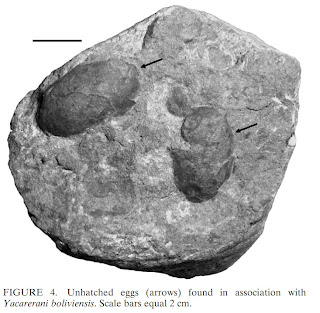Yacarerani boliviensis
Etymology— Generic name derives from two words of the Guarani Indian language, yacare´ (the South American crocodile), and rani (first). Specific epithet after the Republic of Bolivia.
FIGURE 2. Yacarerani boliviensis gen. et sp. nov., MNK-PAL5063. Skull and lower jaw
FIGURE 1. Location of fossil site (star) in Amboro National Park, Bolivia. Scale bar equals 200 km.
The Mesozoic record of fossil vertebrates from Bolivia (Fig. 1) was restricted heretofore to Campanian–Maastrichtian dinosaur footprints (e.g., Leonardi, 1989; Sua´rez Riglos, 1995; Lockley et al., 2002; McCrea et al., 2001; Meyer et al., 2001) and isolated and poorly informative dinosaur teeth and bones (Aguilera et al., 1989; Gutierrez and Marshall, 1994). Discovery of several, almost complete skeletons of a new notosuchian taxon constitutes the most important body-fossil discovery for the Mesozoic of
Bolivia, adding substantially to the meager record of this region of South America. At least two partially disarticulated skeletons and two complete eggs were found together in a small area, constituting one of the few available associations of skeletal remains and eggs for extinct crocodyliforms. In this paper we describe this material as a new genus and species. We consider only the skull morphology, because most of available postcranial remains are still under technical preparation.
Institutional Abbreviation — MNK-PAL, Museo ‘Noel Kempff Mercado,’ Santa Cruz de la Sierra, Bolivia.
Yacarerani boliviensis illustrated by *IRIRIV
FIGURE 4. Unhatched eggs (arrows) found in association with Yacarerani boliviensis.
Scale bars equal 2 cm.
FIGURE 5. Strict consensus of 70 most parsimonious trees depicting phylogenetic relationships of Yacarerani boliviensis within Notosuchia.A dataset of 234 characters and 51 taxa, modified from Pol and Apesteguı´a (2005), was analyzed using TNT (Goloboff et al., 2003). Tree statistics: tree length = 749; consistency index = 0.37; retention index = 0.67. Values of Bremer support are shown beside the branches. See Supplementary Data 1 (http://www.vertpaleo.org/publications/JVPContent.cfm) for details. Hatched line indicates uncertainty in the stratigraphic placement of Yacarerani.
Novas, F. E.; Pais, D. F.; Pol, D.; Carvalho, I. D. S.; Mones, A.; Scanferla, A.; and Riglos, M. S. 2009. Bizarre notosuchian crocodyliform with associated eggs from the Upper Cretaceous of Bolivia. Journal of Vertebrate Paleontology 29 (4): 1316–1320. doi:10.1671/039.029.0409
http://www.igeo.ufrj.br/ismar/3/3_32.pdf [Fulltext]





